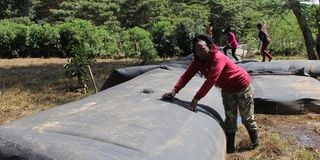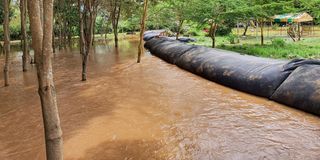Premium
Slamdams: the technology that saved Laikipia from flooding

Ms Margaret Mwangi, a co-director at Fiesta Hotel in Rumuruti Town, Laikipia Town shows slamdams that have protected her business from the adverse effects of flooding. A total of 30 slamdams were deployed here to act as a barrier on River Ngare Narok after forecasts showed it would burst its bank and result in massive flooding.
What you need to know:
- Slamdam technology, borrowed from the Netherlands, uses synthetic tubes filled with water.
- The technology was also demonstrated in Kiambu and Isiolo counties late last year.
A new flood control technology adopted by the Laikipia County Government has seen some parts prone to flooding spared the devastating effects of the ongoing heavy rainfall.
Slamdam technology, borrowed from the Netherlands, uses synthetic tubes filled with water. The tubes are used as flowing water barriers to block flooding waters and push them back to their course.
These mobile flood barriers, also used as water reservoirs, have been used in Nigeria and Burundi to harvest flood waters for irrigation during dry seasons.
It is the first time they are in use in Kenya, with Laikipia being the pioneer county. The technology was also demonstrated in Kiambu and Isiolo counties late last year.
Laikipia Governor Joshua Irungu, who officiated the deployment of the slamdams at Wiyumiririe village in Laikipia North and in Rumuruti Town early this year ahead of the predicted heavy rainfall, said by embracing this technology, the county has been spared the adverse effects of floods, collected and stored over 500,000 litres of water.
“Through the FLoCCA (Financing Locally Led Climate Change Action) programme, we shall be acquiring more slam dams to store water for irrigation. We have been impressed by this technology which is a climate change adaptation measure,” said the governor.
According to James Mwangi, a water expert working with the Netherlands Development Organisation (SNV), one slamdam, which measures one metre in height, has a capacity of holding 8,000 litres of water, and a total of 80 slamdams were installed ahead of the March-May rainy season.

Slamdam technology from the Netherlands has been employed to control flooding in parts of Laikipia County during the current heavy rainfall. A total of 30 Slam dams were deployed near Rumuruti Town, creating a barrier against floods caused by River Ngare Narok and restricting the river to its course. One Slamdam is 5 metres in length, has a height of one metre and a diameter of 1.5metres, capable of storing 8,000 litres of water.
“The County Government and other National Government agencies among them the Water Resources Authority identified Rumuruti Town as prone to floods occasioned by the nearby River Ngare Narok. At Wiyumiririe in Chumvi location, a nearby dam posed a major threat,” said Mwangi.
True to the forecast, River Ngare Narok broke its banks with the waters threatening to overrun a nearby hotel, luckily the 150-metre flood barriers were in place.
“We were able to overcome flooding due to this technology. The slamdams have been of great help to us. If they were not installed on time, the floods would have forced us to close down and definitely there could have been loss of property,” said Margret Mwangi, co-director of Rumuruti Fiesta Hotel, located about 50 metres from the river.
Margret said they have operated the hotel for over a decade and have not been affected by the river flooding, terming the movable water barriers timely intervention that has made them continue with the business amid heavy downpours.
At Chumvi, Matangi Dam, constructed by the Laikipia County Government a few years ago, experienced an overflow forming a wide river but 30 households downstream survived following the deployment of 50 slam dams with a combined length of 250 metres.
“The dam is still full and with heavy rains still pounding parts of Timau and its environs, the danger of overflowing is real but the residents are safe, thanks to this technology,” said Sammy Maina, Ngusishi Water Resource Users Association (WRUA) manager.
Mwangi, the water expert, is calling on county governments to tap into this technology and use floodwaters instead of watching as it goes to waste, causing massive destruction.
“We can fortify our resilience against such disasters but also unlock the potential of leveraging floodwaters as a valuable resource. By implementing appropriate measures, we can harness these waters to augment agricultural productivity, ensuring food security, while concurrently mitigating the adverse impacts of drought.” said the water resources management expert.





